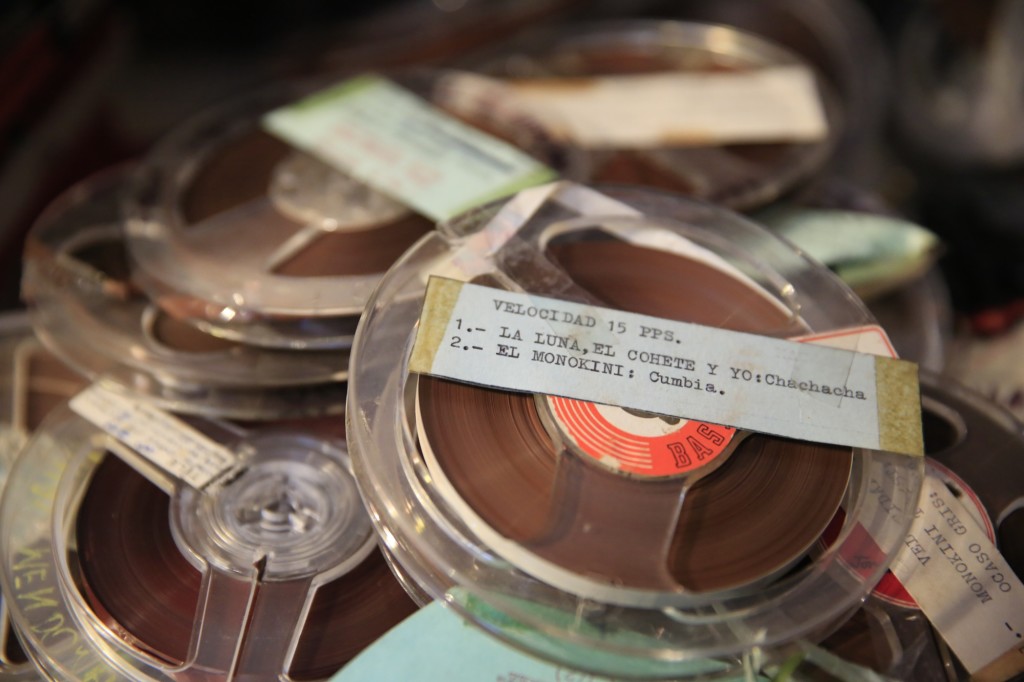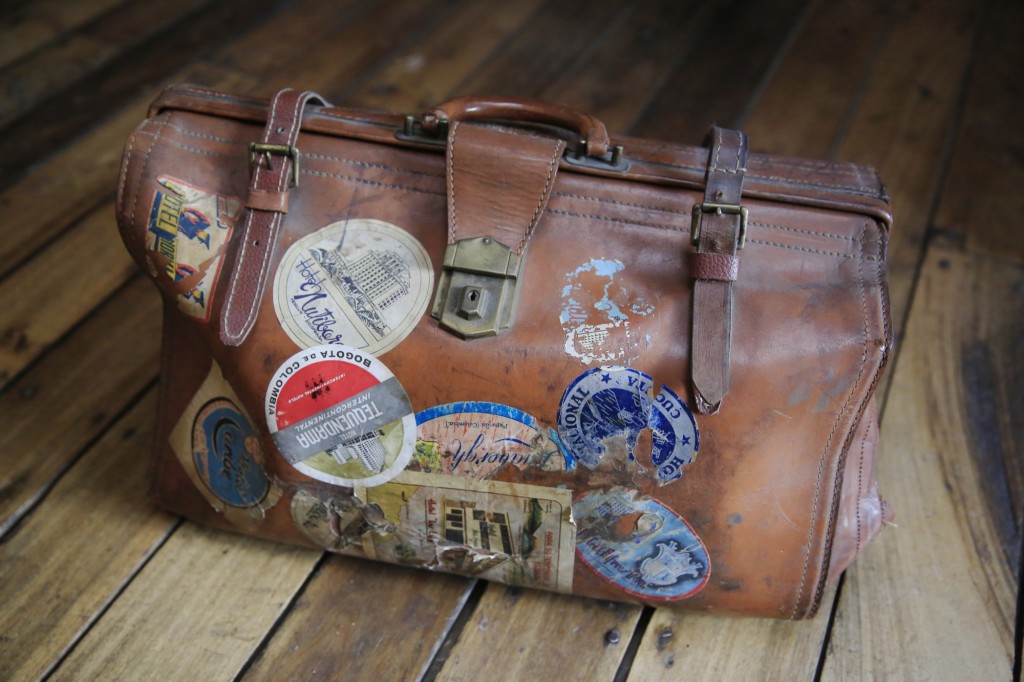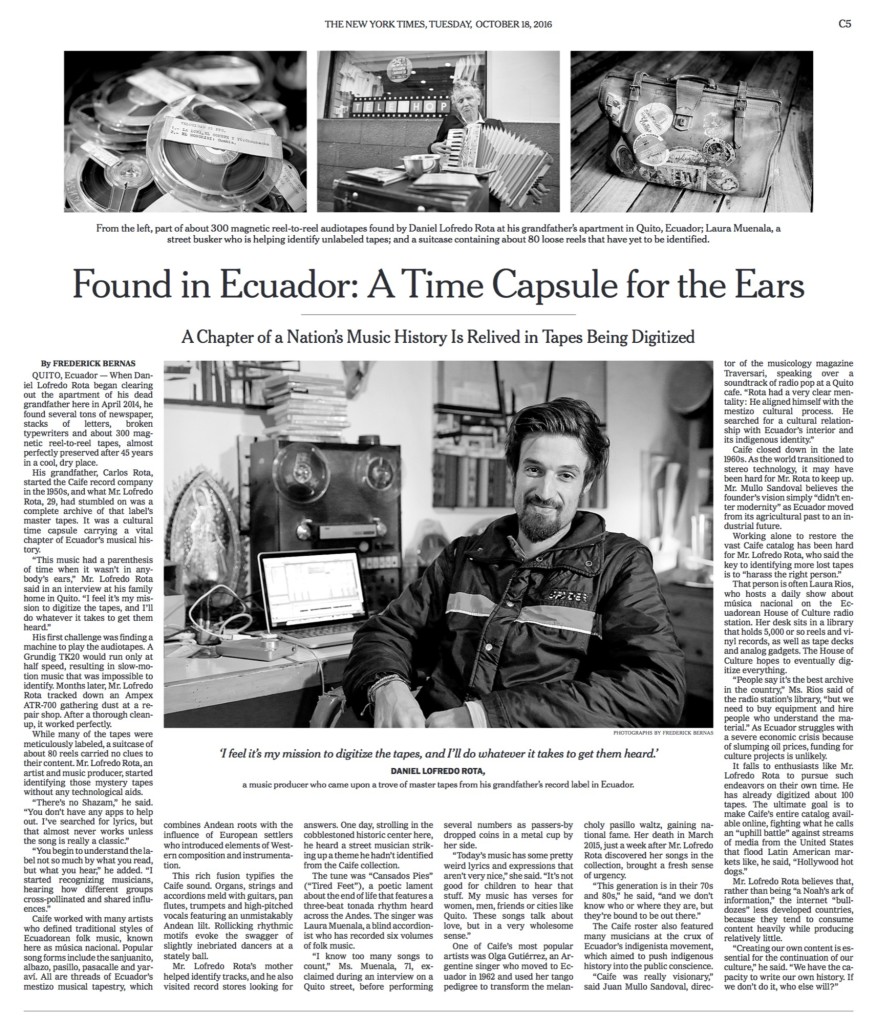
 QUITO, Ecuador — When Daniel Lofredo Rota began clearing out the apartment of his dead grandfather here in April 2014, he found several tons of newspaper, stacks of letters, broken typewriters and about 300 magnetic reel-to-reel tapes, almost perfectly preserved after 45 years in a cool, dry place.
QUITO, Ecuador — When Daniel Lofredo Rota began clearing out the apartment of his dead grandfather here in April 2014, he found several tons of newspaper, stacks of letters, broken typewriters and about 300 magnetic reel-to-reel tapes, almost perfectly preserved after 45 years in a cool, dry place.
His grandfather, Carlos Rota, started the Caife record company in the 1950s, and what Mr. Lofredo Rota, 29, had stumbled on was a complete archive of that label’s master tapes. It was a cultural time capsule carrying a vital chapter of Ecuador’s musical history.
“This music had a parenthesis of time when it wasn’t in anybody’s ears,” Mr. Lofredo Rota said in an interview at his family home in Quito. “I feel it’s my mission to digitize the tapes, and I’ll do whatever it takes to get them heard.”
His first challenge was finding a machine to play the audiotapes. A Grundig TK20 would run only at half speed, resulting in slow-motion music that was impossible to identify. Months later, Mr. Lofredo Rota tracked down an Ampex ATR-700 gathering dust at a repair shop. After a thorough cleanup, it worked perfectly.
While many of the tapes were meticulously labeled, a suitcase of about 80 reels carried no clues to their content. Mr. Lofredo Rota, an artist and music producer, started identifying those mystery tapes without any technological aids.

A suitcase that contained about 80 loose reels with no labels. (Photo: Frederick Bernas)
“There’s no Shazam,” he said. “You don’t have any apps to help out. I’ve searched for lyrics, but that almost never works unless the song is really a classic.”
“You begin to understand the label not so much by what you read, but what you hear,” he added. “I started recognizing musicians, hearing how different groups cross-pollinated and shared influences.”
Caife worked with many artists who defined traditional styles of Ecuadorean folk music, known here as música nacional. Popular song forms include the sanjuanito, albazo, pasillo, pasacalle and yaraví. All are threads of Ecuador’s mestizo musical tapestry, which combines Andean roots with the influence of European settlers who introduced elements of Western composition and instrumentation.
This rich fusion typifies the Caife sound. Organs, strings and accordions meld with guitars, pan flutes, trumpets and high-pitched vocals featuring an unmistakably Andean lilt. Rollicking rhythmic motifs evoke the swagger of slightly inebriated dancers at a stately ball.
Mr. Lofredo Rota’s mother helped identify tracks, and he also visited record stores looking for answers. One day, strolling in the cobblestoned historic center here, he heard a street musician striking up a theme he hadn’t identified from the Caife collection.
The tune was “Cansados Pies” (“Tired Feet”), a poetic lament about the end of life that features a three-beat tonada rhythm heard across the Andes. The singer was Laura Muenala, a blind accordionist who has recorded six volumes of folk music.
Dúo Benítez Valencia – “Cansados Pies”
“I know too many songs to count,” Ms. Muenala, 71, exclaimed during an interview on a Quito street, before performing several numbers as passers-by dropped coins in a metal cup by her side.
“Today’s music has some pretty weird lyrics and expressions that aren’t very nice,” she said. “It’s not good for children to hear that stuff. My music has verses for women, men, friends or cities like Quito. These songs talk about love, but in a very wholesome sense.”

Laura Muenala, 71, a street busker in Quito who is helping identify unlabeled tapes from the Caife collection. (Photo: Frederick Bernas)
One of Caife’s most popular artists was Olga Gutiérrez, an Argentine singer who moved to Ecuador in 1962 and used her tango pedigree to transform the melancholy pasillo waltz, gaining national fame. Her death in March 2015, just a week after Mr. Lofredo Rota discovered her songs in the collection, brought a fresh sense of urgency.
“This generation is in their 70s and 80s,” he said, “and we don’t know who or where they are, but they’re bound to be out there.”
The Caife roster also featured many musicians at the crux of Ecuador’s indigenista movement, which aimed to push indigenous history into the public conscience.
“Caife was really visionary,” said Juan Mullo Sandoval, director of the musicology magazine Traversari, speaking over a soundtrack of radio pop at a Quito cafe. “Rota had a very clear mentality: He aligned himself with the mestizo cultural process. He searched for a cultural relationship with Ecuador’s interior and its indigenous identity.”
Caife closed down in the late 1960s. As the world transitioned to stereo technology, it may have been hard for Mr. Rota to keep up. Mr. Mullo Sandoval believes the founder’s vision simply “didn’t enter modernity” as Ecuador moved from its agricultural past to an industrial future.
Working alone to restore the vast Caife catalog has been hard for Mr. Lofredo Rota, who said the key to identifying more lost tapes is to “harass the right person.”
That person is often Laura Rios, who hosts a daily show about música nacional on the Ecuadorean House of Culture radio station. Her desk sits in a library that holds 5,000 or so reels and vinyl records, as well as tape decks and analog gadgets. The House of Culture hopes to eventually digitize everything.
“People say it’s the best archive in the country,” Ms. Rios said of the radio station’s library, “but we need to buy equipment and hire people who understand the material.” As Ecuador struggles with a severe economic crisis because of slumping oil prices, funding for culture projects is unlikely.

Music producer Daniel Lofredo Rota at his family home in Quito. (Photo: Frederick Bernas)
It falls to enthusiasts like Mr. Lofredo Rota to pursue such endeavors on their own time. He has already digitized about 100 tapes. The ultimate goal is to make Caife’s entire catalog available online, fighting what he calls an “uphill battle” against streams of media from the United States that flood Latin American markets like, he said, “Hollywood hot dogs.”
Mr. Lofredo Rota believes that, rather than being “a Noah’s ark of information,” the internet “bulldozes” less developed countries, because they tend to consume content heavily while producing relatively little.
“Creating our own content is essential for the continuation of our culture,” he said. “We have the capacity to write our own history. If we don’t do it, who else will?”
Published by The New York Times, 17/10/16 – click here for original.






